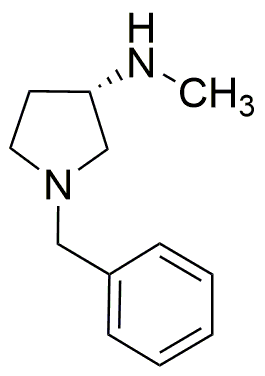(3S)-(+)-1-Benzyl-3-(methylamino)pyrrolidine is widely utilized in research focused on
- Pharmaceutical Development: This compound serves as a key intermediate in the synthesis of various pharmaceuticals, particularly in the development of medications targeting neurological disorders.
- Neuroscience Research: It is used in studies exploring neurotransmitter systems, helping researchers understand the mechanisms of action for drugs affecting mood and cognition.
- Analytical Chemistry: The compound is employed as a standard in chromatographic techniques, aiding in the accurate analysis of complex mixtures in drug formulation and quality control.
- Biochemical Studies: Its unique structure allows it to interact with specific receptors, making it valuable in investigating receptor-ligand interactions in cellular signaling pathways.
- Drug Design: Researchers leverage its properties to design and optimize new compounds with improved efficacy and reduced side effects in therapeutic applications.
General Information
Properties
Safety and Regulations
Applications
(3S)-(+)-1-Benzyl-3-(methylamino)pyrrolidine is widely utilized in research focused on
- Pharmaceutical Development: This compound serves as a key intermediate in the synthesis of various pharmaceuticals, particularly in the development of medications targeting neurological disorders.
- Neuroscience Research: It is used in studies exploring neurotransmitter systems, helping researchers understand the mechanisms of action for drugs affecting mood and cognition.
- Analytical Chemistry: The compound is employed as a standard in chromatographic techniques, aiding in the accurate analysis of complex mixtures in drug formulation and quality control.
- Biochemical Studies: Its unique structure allows it to interact with specific receptors, making it valuable in investigating receptor-ligand interactions in cellular signaling pathways.
- Drug Design: Researchers leverage its properties to design and optimize new compounds with improved efficacy and reduced side effects in therapeutic applications.
Documents
Safety Data Sheets (SDS)
The SDS provides comprehensive safety information on handling, storage, and disposal of the product.
Product Specification (PS)
The PS provides a comprehensive breakdown of the product’s properties, including chemical composition, physical state, purity, and storage requirements. It also details acceptable quality ranges and the product's intended applications.
Certificates of Analysis (COA)
Search for Certificates of Analysis (COA) by entering the products Lot Number. Lot and Batch Numbers can be found on a product’s label following the words ‘Lot’ or ‘Batch’.
*Catalog Number
*Lot Number
Certificates Of Origin (COO)
This COO confirms the country where the product was manufactured, and also details the materials and components used in it and whether it is derived from natural, synthetic, or other specific sources. This certificate may be required for customs, trade, and regulatory compliance.
*Catalog Number
*Lot Number
Safety Data Sheets (SDS)
The SDS provides comprehensive safety information on handling, storage, and disposal of the product.
DownloadProduct Specification (PS)
The PS provides a comprehensive breakdown of the product’s properties, including chemical composition, physical state, purity, and storage requirements. It also details acceptable quality ranges and the product's intended applications.
DownloadCertificates of Analysis (COA)
Search for Certificates of Analysis (COA) by entering the products Lot Number. Lot and Batch Numbers can be found on a product’s label following the words ‘Lot’ or ‘Batch’.
*Catalog Number
*Lot Number
Certificates Of Origin (COO)
This COO confirms the country where the product was manufactured, and also details the materials and components used in it and whether it is derived from natural, synthetic, or other specific sources. This certificate may be required for customs, trade, and regulatory compliance.


